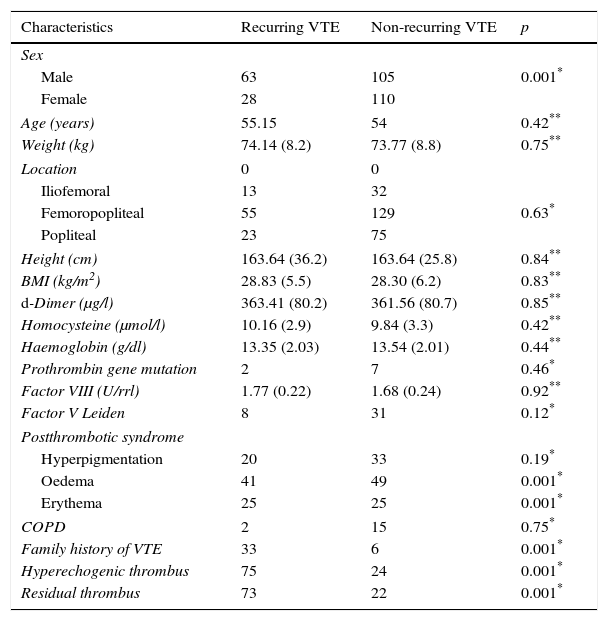Oral anticoagulant therapy for more than 6 months in patients with an episode of idiopathic thromboembolic disease is controversial. The objective was to determine predictive clinical signs that identify patients at increased risk of thromboembolic recurrence after stopping anticoagulant therapy for 6 months after an episode of idiopathic deep vein thrombosis (DVT).
Patients and methodsA prospective study which included 306 consecutive patients with a first episode of idiopathic DVT from June 2012 to June 2014. Predictor variables of recurrent thromboembolic disease and episodes of recurrence during follow-up of the patients (28.42 months) were collected. We performed a multivariate analysis to analyse possible predictors (p<0.20) and an analysis of Kaplan–Meier to establish mean recurrence-free survival.
ResultsWe identified 91 episodes of residual vein thrombosis on follow-up of the patients (37.5% men and 20.3% women) (OR 1.84; 95% CI 1.25–2.71). In the Cox regression analysis stratified by gender, variables showed significant presence of hyperechoic thrombus (p=0.001) in males, and persistence of residual thrombus in women (p=0.046). The mean recurrence-free survival was shorter in both groups.
ConclusionsThe presence of echogenic thrombus in men and the existence of residual DVT in women were 2 clinical signs associated with increased risk of thromboembolic recurrence after stopping anticoagulant therapy for 6 months after an episode of idiopathic DVT in our study.
El tratamiento anticoagulante oral durante más de 6 meses en pacientes con un episodio de enfermedad tromboembólica idiopática es controvertido. El objetivo fue determinar los signos clínicos predictores que permiten identificar a los pacientes con mayor riesgo de recurrencia tromboembólica después de suspender el tratamiento anticoagulante de 6 meses, tras un episodio de trombosis venosa profunda (TVP) idiopática.
Pacientes y métodosEs un estudio prospectivo en el que se incluyeron 306 pacientes consecutivos diagnosticados de un primer episodio de TVP idiopática desde junio de 2012 a junio de 2014. Se recogieron los datos de variables predictoras de enfermedad tromboembólica recurrente y los episodios de recurrencia durante el seguimiento de los pacientes (28,42 meses). Realizamos un análisis multivariable para analizar las posibles variables predictoras (p<0,20) y un análisis de supervivencia de Kaplan-Meier para establecer el tiempo medio libre de recidiva.
ResultadosIdentificamos 91 episodios de enfermedad tromboembólica recurrente durante el seguimiento de los pacientes (37,5% varones y 20,3% mujeres) (OR 1,84; IC al 95% 1,25-2,71). En el análisis de regresión de Cox estratificado por sexo se mostraron significativas las variables presencia de trombo hiperecogénico (p=0,001) en varones y persistencia de trombo residual en mujeres (p=0,046). El tiempo medio libre de recidiva fue más corto en ambos grupos.
ConclusionesLa presencia de trombo hiperecogénico en los varones y la existencia de TVP residual en las mujeres fueron 2 signos clínicos predictores asociados a un mayor riesgo de recurrencia tromboembólica después de suspender el tratamiento anticoagulante de 6 meses, tras un episodio de TVP idiopática en nuestro estudio.








